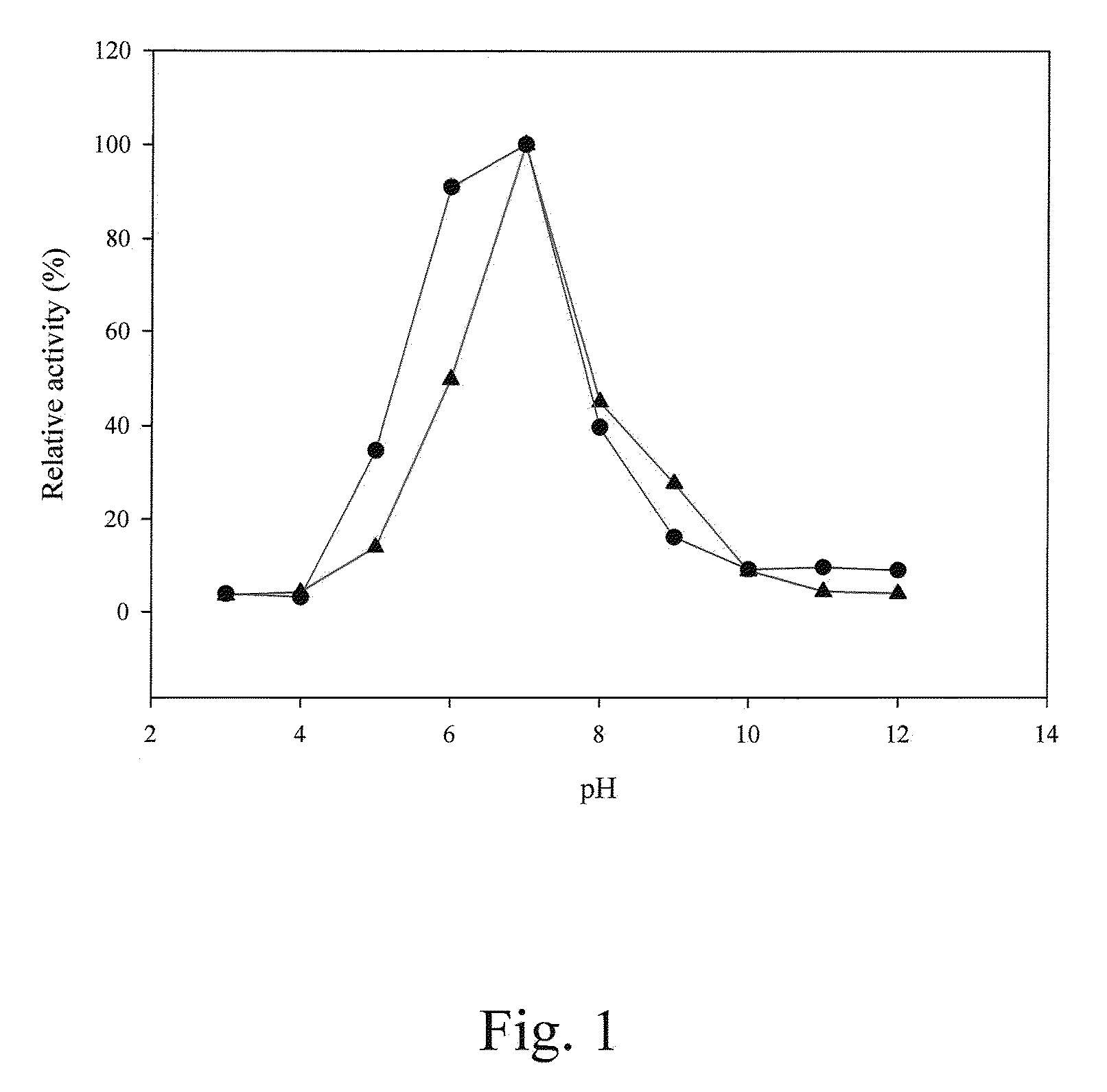Protein Having Prolyl Oligopeptidase Activity, Nucleic Acid Encoding Same and Method for Producing and Using Same
a technology of prolyl oligopeptidase and protein, applied in the field of protein, can solve the problem of oligopeptidases exhibiting lower heat stability
- Summary
- Abstract
- Description
- Claims
- Application Information
AI Technical Summary
Benefits of technology
Problems solved by technology
Method used
Image
Examples
example 1
Construction of Coprinus clastophyllus cDNA Library and Cloning of Prolyl Oligopeptidase cDNA
[0065]1. Cloning of Coprinus clastophyllus Prolyl Oligopeptidase Gene Fragments and Preparation of Probes
[0066]Fungal genomic sequences were searched on NCBI web site by BLAST with the amino acid sequence of human prolyl oligopeptidase. Polymerase chain reaction (PCR) primers Pro16 and Pro17 were designed from regions of the genomes of Coprinopsis cinerea okayama7#130 and Phanerochaete chrysosporium RP-78 where high similarity to the prolyl oligopeptidase sequence was observed and have been attached, respectively as:
Pro16:5′-tacggcggmt tcascatctc-3′(SEQ ID NO: 1)Pro17:5′-tgccaytcyt cwccraactc-3′(SEQ ID NO: 2)
[0067]The genomes of Coprinopsis cinerea okayama7#130 and Phanerochaete chrysosporium RP-78 are publicly available in databases maintained by the U.S. National Center for Biotechnology Information (Bethesda, Md.).
[0068]PCR was carried out using PCR primers Pro16 and Pro17 and genomic DNA...
example 2
Expression of Coprinus clastophyllus Prolyl Oligopeptidase cDNA in E. coli
[0107]Primers Pro31 and Pro32 were designed to generate a stop codon in an amplified full-length prolyl oligopeptidase cDNA using PCR with pfu DNA polymerase.
Pro 31:5′-atggtgacca aaacctgggt-3′(SEQ ID NO: 7)Pro 32:5′-ctagagtgta gctttatctt tc-3′(SEQ ID NO: 8)
[0108]PCR program:
[0109]94° C., 3 minutes [1 repeat];
[0110]94° C., 30 seconds, 58° C., 30 seconds, 72° C., 180 seconds [35 repeats];
[0111]72° C., 3 minutes [1 repeat].
[0112]The amplified full-length prolyl oligopeptidase cDNA was ligated into an expression vector pET 151 / D-TOPO (Invitrogen) comprising a T7 primer corresponding sequence and an N-terminal His-tag. A recombinant construct was obtained as a result of the ligation. The recombinant construct was then used to transform host cells. The host cells were DH10B E. coli strain cells (Invitrogen). The host cells were cultured at 37° C. in LB broth (USB) or on LB plates (USB). Multiple colonies were obtai...
example 3
Measuring Activity of Coprinus clastophyllus Prolyl Oligopeptidase
[0114]1. Selecting pProHN14 and pProHN17 and Measuring Prolyl Oligopeptidase Activities of Proteins Encoded Thereby
[0115]400 μl of 0.1 M Na-phosphate buffer, 50 μl of 10 mM Z-glycyl-L-proline-4-nitroanilide (Fluka) and 50 μl of diluted solution of the aforementioned protein having prolyl oligopeptidase activity were added into a micro centrifuge tube. The mixture was allowed to react for 5 to 60 minutes. 500 μl of 1N HCL quenching solution was added to quench the reaction. After 13000 rpm centrifugation for 5 minutes, the supernatant was obtained to measure the reading of OD410.
[0116]The amount of p-nitroaniline was determined with a stand curve of OD410 readings versus p-nitroaniline amounts. At pH 7.0 and 45° C., 1 U of prolyl oligopeptidase activity was defined as the ability to generate 1 μmole of p-nitroaniline per minute.
[0117]The reading of OD410 was than used to determine the prolyl oligopeptidase activities s...
PUM
| Property | Measurement | Unit |
|---|---|---|
| temperature | aaaaa | aaaaa |
| temperature | aaaaa | aaaaa |
| pH | aaaaa | aaaaa |
Abstract
Description
Claims
Application Information
 Login to View More
Login to View More - R&D
- Intellectual Property
- Life Sciences
- Materials
- Tech Scout
- Unparalleled Data Quality
- Higher Quality Content
- 60% Fewer Hallucinations
Browse by: Latest US Patents, China's latest patents, Technical Efficacy Thesaurus, Application Domain, Technology Topic, Popular Technical Reports.
© 2025 PatSnap. All rights reserved.Legal|Privacy policy|Modern Slavery Act Transparency Statement|Sitemap|About US| Contact US: help@patsnap.com



